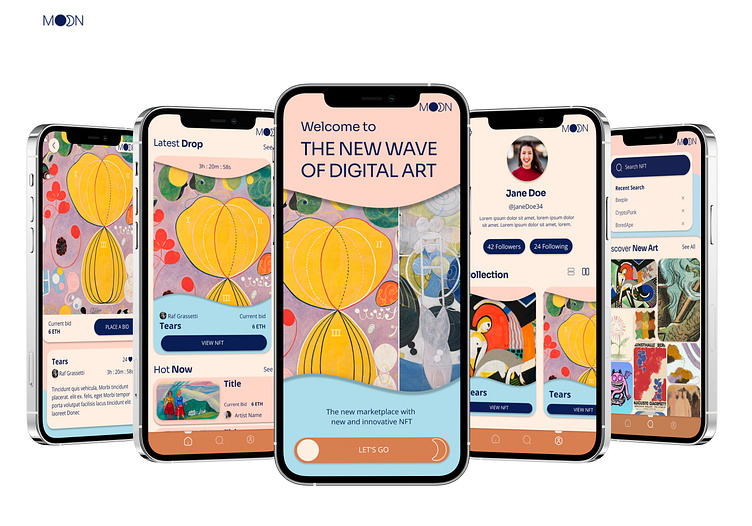Moon | NFT App
As part of Dribbble's four-week UI Design course, I created an NFT Marketplace app called Moon, based on the briefing and wireframes provided in the course.
Moon is a new startup with the goal to revolutionize the NFT marketplace business and the digital art scene. This is a place where tech-savvy people can come to buy and/or sell beautiful and curated digital art.
The objective was to create a visually aesthetic design and then scale it across multiple screens, working with UI principals, building an UI Library, creating a functional prototype and learning to fully use Figma. I also learned about research, visual exploration, design systems, while working with a mentor who provided valuable feedback.
Moodboards
First Moodboard & Concept
I wanted to distance myself from the prevalent neon and "video game" future concepts I found online, so I embarked on a search for organic forms inspired by a dreamier vision of the future. Rounded frames, influenced by the moon's aesthetics, caught my attention. The muted colors of nude, soft greyish pink, earthy brown, and deep yellow added a vintage touch to my vision board.
VINTAGE AND ORGANIC
After the initial mood board, my visual exploration embraced a vintage vibe with earthy brown tones and organic shapes. The subtle nod to the 70s era was intentional but had a modern twist. It was also my first time trying out wireframes and Figma tools. The concept was still vague and experimental, so I found it necessary to further experiment in crafting the second moodboard.
Second Moodboard & Concept
In crafting the second moodboard, I delved into a dystopian concept of the future, drawing inspiration from cinematic and TV depictions. Simultaneously, I embarked on a quest for fonts that could blend modernity and vintage aesthetics. These references evoked echoes of the Bauhaus and Modernism movements, allowing me to capture the fusion of contemporary and classic sensations I had in mind.
MODERN & COLOURFUL
In this visual exploration, I began to test with a more extensive color range, aiming to infuse a modern twist into my 'vintage' concept, distinguishing it from the initial iteration. My desire was to incorporate the notion of a 'wave' since the app's overarching aim was to represent 'the new wave of digital art.' I retained some rounded elements to complement this wave concept. While the second concept exhibited more personality, it still required refinement, making it my choice for further development and scaling.
Polishing & Scaling Design
I scaled the second design concept to create a cohesive, pleasing and captivating user interface across all screens. I focused on the responsive design, integrity of the design concept and kept my attention on every detail.
I also created a logo to help me with the modern concept I wanted for the app and worked with the wave form and rounded edges.
Design System
While polishing and scaling the Moon App, I had to choose fonts and a colour palette. I also created several components. All of that together became an UI Library.
Prototype
The Moon app prototype act as a functional representation of the ultimate UI design, offering a practical and fully operational preview of the app's features and intricacies.
It enabled me to evaluate the intuitiveness of the interactions I had incorporated, including elements like image carousels and bottom sheets. Moreover, it provided an opportunity to gauge the initial impressions of others regarding my visual aesthetics when experienced on an actual mobile device.
Image Credits
Zur Farbenlehre Pl.02 (1810), Johann Wolfgang Von Goethe (German, 1749-1832)
The Thundershower (study for painting) (ca. 1916), Henry Lyman Saÿen (American, 1875-1918)
Florian’s Café, Venice (1910), Francis Campbell Boileau Cadell (Scottish, 1883 - 1937)
Another party heard from (1898), John Samuel Pughe (American, 1870-1909)
Ohne Titel; aus; ‘Die 150 Blätter’ IX (1940), Karl Wiener (Austrian, 1901-1949)
Abstraktion In Orange, Gelb Und Grün, Augusto Giacometti (Swiss, 1877 – 1947)
Kunsthalle Bern, Augusto Giacometti, Hermann Haller, P.-E. Vibert (1924), Augusto Giacometti (Swiss, 1877 – 1947)
Pardon Us (1931), Eric Rohman (Swedish, 1891 - 1949)
Egyptian No. 8 (1856), Owen Jones (English, 1809 - 1874)
Group IV, No. 7, The Ten Largest, Adulthood (1907), Hilma af Klint (Swedish, 1862 – 1944)
Turkish Bath (1915), Charles Demuth (American, 1883-1935)
Sunflower, Charles Demuth (American, 1883-1935)
The Large Figure Paintings, No. 5 Group 3 (1907), Hilma af Klint (Swedish, 1862 – 1944)
Floral design for printed textile Pl XXVIII (1800–1818)














